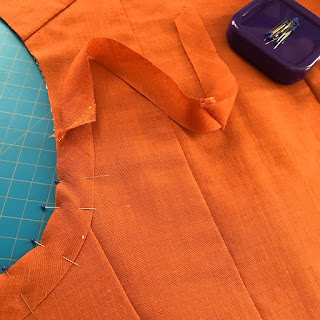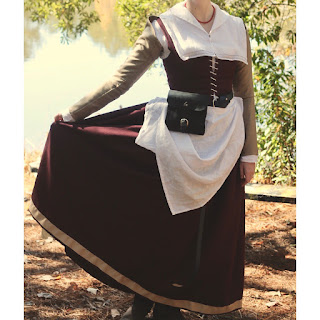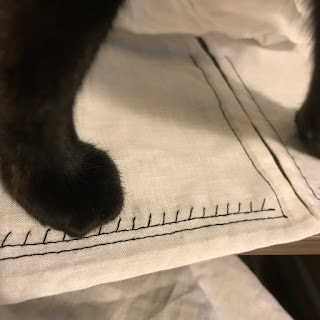Quality sewing on a budget
Not everyone is utterly determined to use period-appropriate or even natural-fiber materials in their historical sewing. No judgment! It doesn't have to be a sticking point. If you do want to use more linen and wool than polyester and quilting cotton, though, I hope you'll find some of this useful.
How can I save money?
First and foremost, shop the sales. Holiday specials can be a godsend, but check out sale/clearance/remnant sections at any time.
In that vein, be willing to search. I keep a whole roster of sites (see end of post) that I check for fabric at reasonable prices. There are certain shops that cater to historical costumers who prefer period materials, but with some patience and careful checking of fiber content, more mainstream stores can also be treasure troves.
Once you get your hands on the fabric you want, remember that piecing is period. Historically, fabric represented a huge investment, so economical use of what yardage a person could afford was totally normal! Basic-construction pieces like the rectangles and triangles of shifts are pretty easy to finagle into limited material, but even garments with more complex shapes can be hacked together from scraps (like the back of my orange kirtle). Lining is an excellent place to deploy that kind of economy.
 |
| Piecing on piecing on piecing... |
Keep thinking historically and waste not, want not. Every single scrap of fabric or bit of thread that I clip off remains in my stash. I separate these trimmings into categories: cabbage, made up of larger pieces that can serve as mockup material, linings, or even complete small items; scraps, which are usually smaller strips that might still have an obscure use as a patch or to fill in a narrow spot; and fluff, which is scrap that I've cut up into itty bitty pieces to use as stuffing. Both my Elizabethan bum-roll and Edwardian bustle pad are, like Winnie the Pooh, stuffed with fluff.
...But you don't always have to think historically. At a certain point, thread is thread, and I've got polyester-machined seams beneath plenty of pretty linen hand-finishing.
 |
| What's inside? Months of trimmings. |
Where should I invest?
The answer to this depends on you. Consider the purpose of your project, especially how you're planning to wear it. Because my Elizabethan garb is intended to be worn outdoors for long periods, I decided to invest in good-quality linen for smocks and wool for kirtles, both of which facilitate body-temperature control and are antimicrobial (read: less stinky). My Elizabethan waistcoat, however, won't see nearly as much wear, so I saved money by using cotton flannel at $2/yard instead of wool flannel that would be significantly more expensive.
I personally prefer to put my money into the garments that are most versatile. Although I made my Elizabethan kirtles with lower- or middle-class portrayals in mind, upper-class ensembles rely on the same basic pieces. If I ever decide to go noble, then, my wool kirtles will be perfectly suitable for sitting underneath a fancy forepart and gown.
 |
| An investment piece: this kirtle can span multiple classes and eras. |
Of course, it's not all about the fabric. If you're sewing on a machine, maintain it! I got my Bernina 1008 for free when a high school home-ec course folded. The machine is from 1985. With $160 invested in a tune-up and replacing a part, it now runs like a dream, and if I keep it mechanically healthy I'm willing to bet it could last another 35 years. I'm certainly not suggesting that you go and drop big money on a machine if you don't have one – hand sewing made every garment before 1755! – but it's worth keeping an existing machine in good condition.
What else do you got?
Time is money: putting effort into small, low-cost touches can infinitely heighten the appearance of your garment. Simple black thread in a blanket stitch along the cuffs of a shift is near-instant blackwork. Polyester grosgrain ribbon is a perfect skirt-guard. Basically, look to the details. There are plenty of cheap modern materials that, when used effectively, can take a piece to the next level.
 |
| Kick it up a notch! Let the cat help. |
Choose your garments wisely. If you want to use period materials without breaking the bank, then for heaven's sake, don't try to dress like a courtier. I've never bought silk in my life, but I can manage a pretty damn good impression of an Elizabethan common woman in period-appropriate linen and wool. Plus, like I said above, those basic garments really are basic – they're the foundation of clothing in virtually every class, and that holds true for many historical periods.
Last but not least: never, ever underestimate the value of research to get your silhouettes and construction right.
 |
| Nailing your waistline is half the battle. |
Okay, but where do I shop?!
My bookmarks tab has got you covered, friend. An asterisk * marks a shop that I've personally patronized and can positively recommend.
Specialty historical shops:
Mainstream shops (check fiber content!):
Did I miss anything important? How do you stay on budget when sewing various things?



Comments
Post a Comment